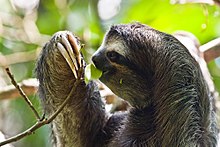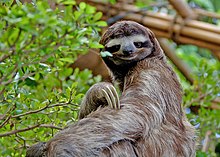Sloths are arboreal mammals noted for slowness of movement and for spending most of their lives hanging upside down in the trees of the tropical rainforests of South America and Central America. The six species are in two families: two-toed sloths and three-toed sloths. In spite of this traditional naming, all sloths actually have three toes. The two-toed sloths have two digits, or fingers, on each forelimb.[3]
The sloth is so named because of its very low metabolism and deliberate movements, sloth being related to the word slow. This is an evolutionary adaptation to their low-energy diet of leaves, and to avoid detection by predatory hawks and cats who hunt by sight.[3] Sloths are almost helpless on the ground, but are able to swim.[4] The grooved hairs of the sloth's shaggy coat is a host to symbiotic green algae which helps the sloth camouflage itself in the trees, and provides nutrients to the sloth. The algae is in turn nourished by sloth moths, some species of which exist solely on sloths....
Ground sloths lived in South America and, after the Great American Interchange, North America. They disappeared shortly after the appearance of humans about 10,000 years ago. Evidence suggests human hunting contributed to the extinction of the American megafauna. Ground sloth emains found in both North and South America indicate that they were killed, cooked, and eaten by humans.[4] Climate change that came with the end of the last ice age may have also played a role. Megalocnus survived on the Antilles until about 5000 years ago, long after other ground sloths died out on the mainland, but then went extinct when human finally arrived there too.[15]
Biology
Physiology
Sloths can be 60–80 centimeters long and, depending on species, weigh from 3.6 to 7.7 kilograms. Two-toed sloths are slightly larger.[16] Sloths have long limbs and rounded heads with tiny ears. Three-toed sloths also have stubby tails about 5–6 cm long. While almost all mammals have seven cervical vertebrae, two-toed sloths have only six, while three-toed sloths have nine,[17] allowing them to rotate their heads through 270 degrees.[18]
Sloths have colour vision, but have poor visual acuity. They also have poor hearing. Thus, they rely on their sense of smell and touch to find food.[19]
...
Activity
Their limbs are adapted for hanging and grasping, not for supporting their weight. Muscles make up only 25 to 30 percent of their total body weight. Most other mammals have a muscle mass that makes up 40 to 45 percent of the total body weight.[26]Their specialised hands and feet have long, curved claws to allow them to hang upside down from branches without effort,[27]and are used to drag themselves along the ground, since they cannot walk. On three-toed sloths, the arms are 50 percent longer than the legs.[19]
Sloths move only when necessary and even then very slowly. They usually move at an average speed of 4 m per minute, but can move at a marginally higher speed of 4.5 m (15 ft), if they are in immediate danger from a predator. X While they sometimes sit on top of branches, they usually eat, sleep, and even give birth hanging from branches. They sometimes remain hanging from branches even after death. On the ground, the maximum speed of sloths is 3 m per minute. Sloths are surprisingly strong swimmers and can reach speeds of 13.5 m (45 ft) per minute.[28] They use their long arms to paddle through the water and can cross rivers and swim between islands.[29] Sloths can reduce their already slow metabolism even further and slow their heart rate to less than a third of normal, allowing them to hold their breath underwater for up to 40 minutes.[30]
Wild brown-throated three-toed sloths sleep on average 9.6 hours a day.[31] Two-toed sloths are nocturnal.[32] Three-toed sloths are mostly nocturnal, but can be active in the day. They spend 90 per cent of their time not motionless.[19]
Diet
Baby sloths learn what to eat by licking the lips of their mother.[33] All sloths eat the leaves of the cecropia.
Two-toed sloths have a diverse diet of insects, leaves, carrion, fruits, leaves and small lizards, ranging over up to 140 hectares. Three-toed sloths, on the other hand, have a limited diet of leaves from only a few trees, and no mammal digests as slowly.
They have made adaptations to arboreal browsing. Leaves, their main food source, provide very little energy or nutrients, and do not digest easily, so sloths have large, slow-acting stomachs with multiple compartments in which symbiotic bacteria break down the tough leaves. As much as two-thirds of a well-fed sloth's body weight consists of the contents of its stomach, and the digestive process can take a month or more to complete.
Three-toed sloths go to the ground to urinate and defecate about once a week, digging a hole and covering it afterwards. They go to the same spot each time and are vulnerable to predation while doing so. This may be relevant for maintaining the ecosystem in the sloths' fur.[34] Individual sloths tend to spend the bulk of their time feeding on a single "modal" tree; by burying their excreta near the trunk of that tree, they may help nourish it.[35] Recent research shows that moths, which live in the sloth's fur, lay eggs in the sloth's feces. When they hatch, the larvae feed on the feces, and when mature fly up onto the sloth above.[5]
...
Human relations
The majority of recorded sloth deaths in Costa Rica are due to contact with electrical lines and poachers. Their claws also provide another, unexpected deterrent to human hunters; when hanging upside-down in a tree, they are held in place by the claws themselves and often do not fall down even if shot from below.
Sloths are victims of animal trafficking where they are sold as pets. However they make very poor pets as they have such a specialized ecology.[43]
The founder and director of the Green Heritage Fund Suriname, Monique Pool, has helped rescue and release more than 600 sloths, anteaters, armadillos, and porcupines.[44]
The Sloth Institute Costa Rica is known for caring, rehabilitating and releasing sloths back into the wild.[45] Also in Costa Rica, the Aviarios Sloth Sanctuary cares for sloths. It rehabilitated and released about 130 individuals back into the wild.[46]However, a report in May 2016 featured two former veterinarians from the facility who were intensely critical of the sanctuary's efforts, accusing it of mistreating the animals





No comments:
Post a Comment